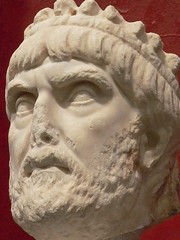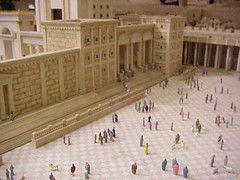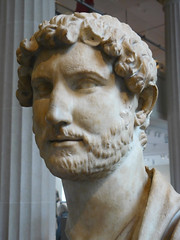Roman Archaeology
Subsection of Roman Times:
Articles about current archaeology and research into the remains of Roman and Byzantine civilizations.
Wednesday, December 07, 2011
Future news about Roman Archaeology to be published to Roman Times
In an effort to simplify my publishing life, I am consolidating this blog with my primary blog, Roman Times. All future news about archaeological discoveries of Roman civilization will henceforth be published on Roman Times. For those of you that follow this blog, I urge you to subscribe to Roman Times instead. Thanks for your interest! - Mary
Tuesday, February 22, 2011
Town Council stands firm on disapproval of builders' plans to erect housing over site of Southwell Roman Villa
A reader sent me a link to this blog post about the battle over developers' plans to build housing on top of the site containing the remains of the Southwell Roman Villa. Some people will never grasp the importance of preservation of our cultural heritage. I'm glad there are still those willing to take a stand against others more interested in profit.
http://priorieshistoricalsociety.blogspot.com/2011/02/news-insult-to-our-history-southwell.html
I wonder if, after all the dust settles in Tunis, Libya, Morocca, etc. new governments will take a pro-preservation stance over Roman remains in those countries? The remains of ancient Carthage were already being overtaken by Tunisian developers building retreats for the wealthy despite verbal obeisance to cultural preservation.
http://priorieshistoricalsociety.blogspot.com/2011/02/news-insult-to-our-history-southwell.html
I wonder if, after all the dust settles in Tunis, Libya, Morocca, etc. new governments will take a pro-preservation stance over Roman remains in those countries? The remains of ancient Carthage were already being overtaken by Tunisian developers building retreats for the wealthy despite verbal obeisance to cultural preservation.
Wednesday, February 02, 2011
Exquisite animal mosaics found in Judean Byzantine remains
 |
| Mosaic floor of a 1500-year-old Byzantine Church in Hirbet Madras, Israel. Image courtesy of the Associated Press. |
"Israeli archaeologists presented a newly uncovered 1,500-year-old church in the Judean hills on Wednesday, including an unusually well-preserved mosaic floor with images of lions, foxes, fish and peacocks.
The Byzantine church located southwest of Jerusalem, excavated over the last two months, will be visible only for another week before archaeologists cover it again with soil for its own protection.
The small basilica with an exquisitely decorated floor was active between the fifth and seventh centuries A.D., said the dig's leader, Amir Ganor of the Israel Antiquities Authority." - Associated Press
The article includes more images including some closeups that are well worth examining.
I also found an interesting web page about Judea under Byzantine rule. An excerpt:
"It was official Christian policy to convert Jews to Christianity, and the Christian leadership used the official power of Rome in their attempts. In 351 CE the Jews revolted against the added pressures of a bad ruler named Gallus. Gallus put down the revolt and destroyed all of the major cities in the Galilee where the revolt had started. Tzippori and Lydda (site of two of the major legal academies) never recovered..."
"...The Jews of Judea received a brief respite in 363 CE when Julian the Apostate became Emperor of the Eastern Kingdom. He tried to return the kingdom to Hellenism and encouraged the Jews to rebuild Jerusalem. The Jews were ecstatic, but their joy was short-lived; Julian was assassinated, and Christian emperors took over, never to lose control again."
 Image via Wikipedia Image via Wikipedia |
| Coin with portrait of Theodosius I |
In the beginning of the fifth century, Emperor Theodosius ruled that because the Jews were the perfidious group that had rejected Jesus, they were to be persecuted. Jews couldn't own slaves (making agriculture difficult). They couldn't build new synagogues. They couldn't hold public office. The Jewish courts couldn't try cases between a Jew and a non-Jew. Intermarriage between Jew and non-Jew was a capital offense as was a Christian converting to Judaism. In addition, Theodosius did away with the Sanhedrin and abolished the post of "Nasi." The Jews received extra tax burdens as well.
 Image by mharrsch via Flickr Image by mharrsch via Flickr |
| Ruler of the Eastern Roman Empire |
"...Justinian added some details to the list in two Edicts. Regulation 37 prohibited Jews from occupying North Africa. The most outrageous edict, however, was Regulation 146, created in 553 CE. Jews were forbidden to read the torah or any other book in Hebrew. Only the Greek version (the Septuagint) could be used. The "Shma" was forbidden. Studying of the Mishnah was forbidden. Justinian encouraged Christians to destroy synagogues, stores, and Jewish houses." - Judea Under Byzantine Rule, The Jewish Virtual Library
Related articles
- Byzantium and Its Sphere (socyberty.com)




Wednesday, January 05, 2011
Remains of Crimean legionary post discovered by Polish team
 |
| City-ruler in the Bosporan Kingdom, Roman vassal state in the Crimea from the Pushkin Museum. Courtesy of Wikipedia. |
“The building that we discovered was several times remodeled: old walls were pulled down and new were erected, floors and roofs were repaired. In 3 A.D. the house was destroyed by fire and much later, probably between 15th and 16th centuries a Tatar settlement replaced the Roman fort,” says the archeologist. - News from Poland
Once known as "Chersonesus Taurica" by the Romans, the Crimean peninsula came under Roman control after Pompey The Great defeated Mithridates VI Eupator in the 1st century BCE. The local client king, Aspurgus, received Roman citizenship and adopted the Roman names "Tiberius Julius" because he enjoyed the patronage of the first two Roman Emperors, Augustus and Tiberius. All of the following kings adopted these two Roman names followed by a third name, mostly of Pontic, Thracian or Sarmatian origin. Bosporan kings struck coinage throughout the kingdom period, which included gold staters bearing portraits of the respective Roman Emperors.
The Romans later built a large naval base at Chersonesos.
Roman troops were stationed in the peninsula, perhaps a division of the Pontic fleet, certainly a detachment of the Moesian army, (other garrisons in Panticapaeum and Chersonesos); their presence even in small numbers showed to the barbarians that the dreaded legionary stood behind (the Bosporanum Regnum). - Mommsen. The Provinces of the Roman Empire p. 317
Related articles





Monday, November 22, 2010
Cleaning up after the Bar Kokhba revolt
 |
| Remains of a Roman bath complex in Herculaneum. Photo by Mharrsch. |
The excavations revealed several plastered bathtubs in the side of the pool, a pipe used to fill it with water, and a white industrial mosaic on the floor of the pool.
The bathhouse tiles, stamped with the symbols "LEG X FR" - Tenth Legion Fretensis - were found in place and the paw print of a dog which probably belonged to one of the soldiers was impressed on the symbol of the legion on one of the roof tiles. - More: News24.com
 Image by mharrsch via Flickr Image by mharrsch via Flickr |
| Model of the Temple in Jerusalem at the Holy Land Experience in Orlando, FL. |
The Legio X Fretensis ("Tenth legion of the sea strait"), had been stationed in Judea after the Great Jewish Revolt in 70 CE. Jewish unrest, however, continued to plague the Roman provincial government. Hostilities finally erupted again after Hadrian announced he would rebuild the Jews holiest city as a Roman metropolis, ploughing up the remains of Herod's temple (The Second Temple) and replacing it with a temple of Jupiter. The leader of the revolt, Simon bar Kokhba was thought to be a Jewish messiah and rebels announced the "era of redemption of Israel". Over 580,000 Jews were killed during the Bar Kokhba revolt (132–136 CE) and 50 fortified towns and 985 villages razed. Bar Kokhba as well as ten leading members of the Sanhedrin were executed and thereafter Hadrian prohibited Torah law and the Hebrew calendar.
 Image by mharrsch via Flickr Image by mharrsch via Flickr |
| Portrait sculpture of the Roman Emperor Hadrian found at Tivoli |
Modern historians have come to view the Bar-Kokhba Revolt as being of decisive historic importance. The massive destruction and loss of life occasioned by the revolt has led some scholars to date the beginning of the Jewish diaspora from this date. They note that, unlike the aftermath of the First Jewish-Roman War chronicled by Josephus, the majority of the Jewish population of Judea was either killed, exiled, or sold into slavery after the Bar-Kokhba Revolt, and Jewish religious and political authority was suppressed far more brutally. After the revolt the Jewish religious center shifted to the Babylonian Jewish community and its scholars. - Bar Kokhba's Revolt, Wikipedia





Friday, February 26, 2010
Ulysses-adorned amphitheater found near Fiumicino airport
Somehow with all the bustle that always accompanies the approaching holidays I somehow missed seeing this notice of a marvelous find of a "mini-Colosseum" near Rome's Fiumicino airport reported a few months ago. When I visited Ostia in March 2009, I remember reading that much more of the ancient port remained unexcavated because it lay under the Fiumicino airport.
[Image of Ulysses sculpture courtesy of the University of Southhampton]
This small amphitheater, however, is considered part of the ancient Roman port of Portus that actually succeeded Ostia as the Roman Empire's primary port at the mouth of the Tiber River in the second century CE.
Apparently, the site was originally discovered in the 1860s but has remained largely undisturbed since then. Now, researchers have been able to employ 3-D geophysics, computer visualization, environmental analysis and digital recording as well as excavation to reveal the details of what became one of the largest maritime infrastructures of the ancient world.












[Image of Ulysses sculpture courtesy of the University of Southhampton]
This small amphitheater, however, is considered part of the ancient Roman port of Portus that actually succeeded Ostia as the Roman Empire's primary port at the mouth of the Tiber River in the second century CE.
Apparently, the site was originally discovered in the 1860s but has remained largely undisturbed since then. Now, researchers have been able to employ 3-D geophysics, computer visualization, environmental analysis and digital recording as well as excavation to reveal the details of what became one of the largest maritime infrastructures of the ancient world.
"With the help of ground penetrating radar, the archaeologists have uncovered luxuriously decorated rooms, a colonnaded garden, a finely carved marble head, possibly depicting the Greek hero Ulysses, and a well-preserved toilet, designed to be used by three people at a time.
"The toilet belonged to the palace. It is located between the amphitheater and a porticoed garden. It is really an impressive building, with marbled floor and walls," said Simon Keay, project director and leading expert in Roman archaeology at the University of Southampton.
The researchers are now analyzing the dirt from the toilet -- basically ancient human waste -- to build a picture of the diet of the people who frequented the site." - More: Discovery News






Subscribe to:
Posts (Atom)




